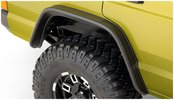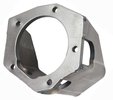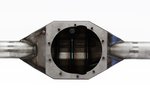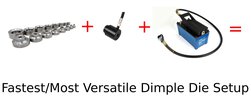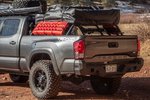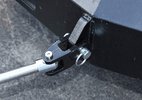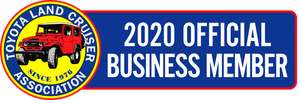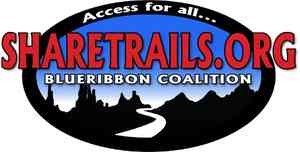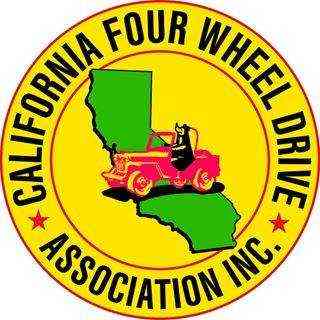D-Ring Shackle Mounts: The Best Bolt-On and Weld-On Mounts
We can all agree that having a D-ring shackle mount break off during a recovery operation could be catastrophic.
But do you know what a good recovery mount looks like?
There are good ones and there are bad ones. You'll see that the good ones all share the same characteristics.
In this article, we'll talk about what to look for in a D-ring or clevis shackle mount and show you 7 bolt-on shackle mounts and 6 weld-on shackle mounts that will never break.
- 6 Reasons Tow Straps with Hooks Will Kill You
- The Winch Recovery Kit Comparison Guide
- Can be relatively inexpensive
- Are easy to install
- Give you a good center-mounted recovery point

The way that winch lines are designed, it's no surprise that they fail all the time.
But D-ring shackle mounts? They should never, ever fail. Ever. A recovery mount failure will send 5-10 lbs of metal flying through the air and will kill or maim any human that it contacts.
You might be wondering if a broken recovery mount is actually more dangerous than a broken winch line or strap:
Yes they are.
A broken strap or winch cable usually only whips
itself through the air. A broken D-ring shackle mount means that the
strap is whipping through the air with 5-10 lbs of metal on the end of
it.
This is far more lethal than a strap by itself, and people have died or been maimed by heavy weights on the end of straps and winch cables.
And it gets worse:
A broken recovery strap or winch cable results in 2 shorter pieces of cable or strap that each carry a portion of the kinetic energy from the failed recovery operation. Each of these pieces has a relatively short reach. However, when a shackle mount breaks, you end up with one long piece of strap or cable with all the kinetic energy plus a weight on the end.
You wouldn’t want to get hit with a simple broken strap or cable, but you have a better chance of living through it than a broken shackle mount.
Recovery dampers work for winch cable and snatch straps but probably won’t be as effective if a shackle mount fails due to the extra weight.
We’re not saying you shouldn’t use a damper - you always should!
For us fourwheelers, recovery mounts and shackles don’t fail if they’re correctly sized for your use. Winch cables fail all the time because they’re weak and snatch straps fail because, like a welder, they have duty cycles that get exceeded by overuse.
So it’s always in your best interest to use a damper. We’ve seen some claims that dampers don’t “work” because a strap or cable still whips. But we know! It’s called a “damper”, not a “stopper”.
Weld-On D-Ring Mounts vs. Bolt-On D-Ring Mounts - Which Wins?
Should you pick
welded d-ring shackle mounts or bolt on d-ring shackle mounts? Well,
first, can you weld? Do you know what a HAZ is and how to minimize
its affect?
If the answer is “No”, then you need to use a bolt-on
D-ring mount. Here's the deal:
D-ring shackle mounts are thick and bumpers are thin (relatively). The HAZ is the Heat Affected Zone of the weld. While you usually want to minimize your HAZ and also keep its temperature from being too hot, its tougher to do when welding metals of dissimilar thicknesses.
Welded vs. Bolted: Neither type of shackle mount will fail in normal recovery operations if attached to your rig properly.
To break it down:
Typical weld-on
D-ring mounts are 3/4” to 1” thick. The typical bumper is 3/16”
to 1/4”. This is a huge difference in thickness when it comes to
welding and requires the right knowledge of where to put heat
and how much juice to use.
To get good weld penetration into a thick
shackle bracket, you need high heat output from your welder.
But:
That high heat output from your welder will also overheat the thin metal of your bumper. Without the proper power output from your welder and some pre and post treatment of each part, you’ll end up with small cracks in your weld and probably a crazy amount of warping in your bumper. It should go without saying that you don’t want to yank on a shackle mount that has cracked welds.
Did you want a shackle hitch?
This mount comes powdercoated with a 3/4" shackle included.
A shackle hitch is a quick and easy way to mount a strap to your 4x4's trailer hitch. They
They're available for Class III (2") to Class V (2.5"-3") receiver hitches. Most fit either a 3/4" or 7/8" D-ring shackle.
We see shackle hitches as more of a mid-range option between factory "recovery mounts" and more serious D ring shackle mounts.
Units like the Liberrway that's pictured often include a 3/4" shackle and are drilled so that they can be mounted in two orientations.
Can you weld and bolt a shackle mount onto your bumper?
Well, you can, but it won't really be stronger than picking one method and doing it right.
This seems to stem from the common idea that metal is like wood. We can screw and glue wood and make it super strong, so why not metal?
In a bolted joint, two pieces of metal are held together by tension in the bolt assembly and friction. In a weld there is no tension and no friction since the job of a proper weld joint is to make 1 piece of metal out of 2. If you weld then bolt, the bolts can’t develop the proper friction and tension due to the rigidity of the weld. If you bolt then weld, a bolt failure will put unnatural tension into the weld joint.
Bolting and welding a shackle mount on is like wearing a belt and suspenders that are made out of one continuous rope. If you cut the belt, then the suspenders will also fail. If you cut the suspenders, then the belt will also fail.
How to Spot an Unbreakable D-Ring Shackle Mount
The short answer:
Look for a D-ring shackle mount that's at least 3/4" thick and has a minimum 7/8" hole to fit a 3/4" shackle. A 1" hole is required to fit a 7/8" shackle. Use only Grade 8 or Grade 10.9 hardware to attach bolt-on mounts.
Below is a longer version of that paragraph above. One thing you won't see is thin materials and light weights!
Materials
The first thing you want
in a shackle mount is steel. The larger your rig, the heavier your shackle mounts
should be. Shackle mounts are made of steel because steel is stronger
than aluminum and it's easy to weld to steel bumpers. Of the few different grades of steel out there, 1018 and 1020 cold-rolled steel are strong and pretty common in shackle mounts.
Hardware
Bolt-on D-ring mounts should come with Grade 8 standard or Grace 10.9 metric hardware. There used to be some silly debate years ago that said you should use Grade 5 hardware over Grade 8 because it would bend before breaking or something.
That’s a bunch of BS:
Grade 8 standard
has a higher breaking strength than Grade 5 standard, end of story.
The same goes for metric hardware.
If your mount comes with Grade 5 standard or Grade 8.8 metric (it shouldn't) or you can't ID the grade somehow, go to your local hardware store and buy the stronger bolts.
Shape
You can get shackle
mounts that stick straight out or point up. The ones that point up
don’t really point up. It’s more that the shackle hole is located
higher relative to your bumper. This gives you more a slightly better
approach angle where your shackles are with the hole bulge up high and
usually matches the lines of modern bumpers a lot better.
For most of us it probably doesn't matter too much, but it can be a little more aesthetically pleasing on certain bumpers.
Thickness and Hole Size
As far as mount thickness goes, you shouldn't use a mount that's less
than 3/4" thick where the D-ring attaches. Most mounts are 3/4" to 1"
thick. For bolt-on clevis mounts, you want the back plate (the one with
the bolt holes) to be at least 3/8" thick.
Recovery operations put massive forces on recovery points, so don't use thin, weak materials.
What does nominal size mean?
Nominal size means "in name only". It's like wood 2x4s - we call them 2x4s, but they're actually 1.5" x 3.5". The nominal size is 2" x 4", but the actual size is 1.5" x 3.5". They are 2x4s in name only. "Nominal size" is a very flexible term. The thing it describes can actually have that measurement somewhere (like shackles) or not (like 2x4s).
One thing you need to know about shackles:
For hole size, you need to know that shackles are named in nominal sizes. They have bodies or bows (the round part) and screw pins (the
straight part). All screw pin shackles have a nominal size, like
3/4”, which describes the diameter of the body. However, in shackles 1/2" and up, the pin
diameter is 1/8” larger than the nominal size.
So for a 3/4” shackle (the nominal size) the bow has a
3/4” diameter and the pin has a 7/8” diameter.
Now:
When you buy a mount, think about the
size of the shackle hole. Do you have different size D-ring shackles?
Are you going to wheel with other people who have bigger shackles
that you might use from time to time? Make sure that your mount can
accommodate a large enough pin size. For most of us a 7/8" or 1" hole diameter will do it.

A standard bow shackle has a screw pin that's 1/8" larger than the nominal (named) size of the shackle.
Also make sure the
shackle mount isn’t so wide at the hole that your shackle won’t
fit it.
This isn’t really an issue with commercial brackets since they're usually 3/4-1" thick, but
could be if you’re doing a homemade shackle mount. Like, you’ll get
some 1 3/8” thick cutoffs at the steel place because you’re cool,
weld them through your bumper into your frame rails to make it
strong, then discover that none of your 3/4” shackles with a 1 1/4”
inside width will fit. Just speaking from experience here....
Like quick and and dirty tricks?
To calculate the inside width of a shackle, multiply the nominal diameter by 1.6. The inside width of the shackle will be at least that wide. So, for a 3/4" shackle, it would be:
3/4" X 1.6 = 1.2"
The true inside width is 1.25" so we're pretty close.
All that said, most shackle mounts that you can buy will fit a 3/4” shackle as that’s the most commonly used D-ring in off roading.
The Non-Rocket Science of Attaching a D-Ring Mount
If you’re doing a weld-on, you know what you’re doing. If you don’t know what you’re doing, just remember that you’re responsible for what happens when your recovery mounts break.
Bolting on a shackle
mount is much easier.
Generally all you have to do is drill some
holes, install your Grade 8 hardware and torque it down. On newer Jeeps, several of the mounts below actually bolt on to factory holes with no drilling.
One important tip for drilling:
Don’t
drill holes larger than the diameter of the hardware. This reduces the fricative area for
your hardware to hold on to which can cause loosening. Loose bolts equal broken bolts.
If you want to add some strength or you plan to do some particularly heinous recoveries, you can strengthen the mount a little if you have access to the back of the mounting surface. You can make up a plate out of 3/16” thick steel that is 0.25”-0.5" larger than the footprint of your shackle mount, and drill it to match your shackle mount’s holes. When mounting everything, you sandwich the bumper between the shackle mount and the backing plate to distribute the load a little more. This is the same technique that’s used to reinforce roll cage mounts that connect above and below the floor of your rig.
7 Bolt-On D-Ring Mounts
Here's a selection of bolt-on D-ring mounts. You'll see that there are a selection of brand (Jeep) or bumper specific mounts. Pay no attention to that! (Unless it applies.) You can easily bolt on most of these mounts to any flat surface. You might have to drill some 1/2" or so holes, but we've tried to supply the bolt patterns for most of these mounts.
EAG D-Ring Shackle Mounts with Shackles and Isolators
These shackle mounts include 2 shackles, 2 mounts, and isolators for both shackles.
These shackle brackets are made for Jeep JKs, but will fit any bumper that you're willing to drill.
This is just a plain ol' good buy. If you don't already have shackles, this set comes with 2 9,500 lb. 3/4" shackles. The shackles have bow and pin isolators to protect your bumper and keep the noise down. These are designed to bolt on to Jeep JK Wranglers but you can drill holes to fit any flat surface. We recommend bolting to bumpers that are at least 3/16" thick. The base plate is 3/8" thick and drilled for a 5.25" x 2.5" pattern. The bolt holes are large enough to fit 1/2" bolts. They have a textured powdercoat finish, so they should look good for a long time. They are drilled to fit up to a 3/4" D-ring.
Rugged Ridge Bolt-On D-Ring Shackle Mount
These mounts are upsloped and designed to fit Rugged Ridge's XHD bumpers.
Rugged Ridge's clevis mounts are designed for their XHD Jeep bumpers, and are meant to be a bolt-on upgrade. But they'll easily bolt to the factory JK mounting holes with their 5.25" x 2.5" bolt pattern. We can use them wherever we want if we're willing to drill some holes! They'll take a 3/4" shackle and have an up-sloped nose to give you just that little extra bit of clearance. They have a textured black powdercoat finish to keep them from rusting and a 3/8" back plate will keep them from bending in extreme recovery operations. Hardware is included.
Trail-Gear Bolt-On D-Ring Shackle Mounts
This 2.5"x2.5" bolt pattern D-ring mount will take a 3/4" shackle.
Trail-Gear offers two clean D-ring mounts with different bolt patterns. One has a 2.5" x 2.5" pattern and the other is a 2.5" x 3.5" pattern. Each mount is made out of laser cut 3/8" and 1" steel. The mounting holes will take 1/2" diameter bolts. The shackle screw pin holes are sized to fit 3/4" shackles. These only come in a bare metal finish, so you get to paint them any color you want. They're sold singly and are pretty inexpensive if you do the work to paint them.
Chassis Unlimited Extra Long D-Ring/Clevis Mount
Extra long shackle mounts are great for bolting or welding inside frame rails. This mount has 3/4" mounting holes for bolting to your frame.
This massive shackle mount from Chassis Unlimited is 1" thick and 2" high. It comes with 3/4" mounting holes - you can weld or bolt it wherever you need it. This type of mount is great for welding through a bumper (cutting a hole in a bumper and welding both sides) and also for bolting directly to your frame horns. They are CNC machined from steel and have all the sharp edges chamfered off. If you need a heavy duty weld-on shackle mount, this is it.
EVO Manufacturing Front D-Ring Mounts for Jeep JKs
The EVO mounts bolt on to Jeep JKs, but can still be used on other 4x4s.
If you need an even beefier Jeep JK Wrangler D-ring shackle mount, these are fully made of 3/4" thick steel! Yup, both the back plate and the shackle pin plate are 3/4" thick, which makes this the mount set with the thickest back plates. They have a 5.25" x 2.5" mounting pattern and hardware is included. The finish is a black powdercoat for long-lasting looks without rust.
EVO Manufacturing Rear Bolt-On D-Ring Shackle Mounts for JKs
These D-ring mounts are perfect a perfect bolt-on solution for your Jeep JK rear.
The mounts slide into the rear frame rails and work well with minimal rear bumpers. They stick out just enough to be useful.
So, we were going for mounts that could be used universally, but we decided to throw these in since we like 'em. Got a Jeep with a minimal rear bumper (like one from EVO)? These mounts slip inside your framerails and bolt in place to give you solid recovery mounts. We like these since they'll give you maximum departure angle in the rear by poking our of the frame just enough to be functional. Installation is bolt-on; no drilling is required. They are designed to work with 3/4" shackles and have a black powdercoat finish.
Rough Country D-Ring Schackle Mounts with Shackles
The Rough Country clevis mounts have a 3/8" backing plate and include 2 3/4" shackles.
These mounts are designed to work only with Rough Country's bumpers, but you can drill your own holes! They have a 2.75" x 2.5" bolt pattern to go onto any flat surface. They have a long lasting black powdercoat finish to keep them looking good long into the zombie apocalypse. Really, blood just washes right off. The two included shackles are standard 3/4" 9,500 lb shackles, although you may want some isolators to keep your bumper looking nice.
6 Weld-On D-Ring Mounts
Here is a selection of weld-on D-ring mounts. If you're surface mounting any of these, make sure you chamfer the edges and get good weld penetration without warping the heck out of your bumper. The longer your weld beads are, the stronger the mount will be. Again, be careful not to overheat your bumper to avoid weakening and warping it.
AtoZ Fabrication Flat Face Clevis Mounts
These heavy-duty mounts from AtoZ come with 3/4" shackles. You'll have to chamfer these yourself for welding.
These 1" weld-on CNC-machined mounts are burly! They are 3.5" tall and measure 2" from the mount surface to the shackle hole center. With a 1" shackle bore, you can fit up to a 7/8" shackle, so these are definitely suitable for larger rigs. The steel is cold-rolled 1018 and they are made in the USA. They are sold in pairs and come with or without a pair of 3/4" shackles. Make sure you bevel the edges before welding!
Barnes 4WD Weld-On D-Ring Shackle Mount
These 1" thick clevis mounts can be welded on to any flat surface with proper pre-weld prepping.
This weld-on surface shackle mount is 1" thick and made with US steel. It's got a 7/8" shackle hole, so you can easily fit a 3/4" shackle. It is beveled on the top and bottom for better weld penetration, but we'd also bevel the sides for better weld penetration. These come in a bare metal finish and are sold individually.
RuffStuff 2"x4" Rectangle Bumper Weld-On Clevis Mount
This clevis mount makes it easy to add a recovery point to any 2"x4" steel bumper.
This shackle mount gives you a ton of weld surface and could be mounted eye-up or eye-down.
Got a 2"x4" steel tube bumper? This clevis mount wraps around your tube or channel bumper to give you a ton of weld surface. Since the 1" bore shackle hole can take up to 7/8" shackles, this is a perfect addition for large rigs. The bracket is 3/4" thick steel. It's 5.75" high and 3" from the mount surface to the furthest point - so not much longer than other shackle mounts. Mount it with the hole up or down.
Chassis Unlimited Round Tube Weld-On D-Ring/Clevis Mount
Coped shackle mounts can be easily welded onto round tubing. These steel mounts are available for 1.75" or 2" tubing.
Need to weld a recovery mount to a round tube? No problem. This mount is coped to fit round tube which saves you a lot of pain and grinding wheels. It's available for tube ODs of 1.75" or 2". They are CNC-machined from 1" thick 1018 steel. They also have machine-chamfered edges that look clean and keep you from cutting yourself on sharp metal. They are 2" high and have a 1" shackle bore so they'll take up to a 7/8" shackle - great for heavy rigs. These are sold individually.
RuffStuff Weld-On Bumper D-Ring Clevis Mount
This is just a solid chunk of steel at 2" x 4.5" x 1" thick. This is a great heavy duty mount.
At 4.5" long this is the perfect mount for welding or bolting inside a frame rail, or for passing through a bumper to weld on the back side.
RuffStuff has another heavy duty weld-on shackle mount here. This one is long and can pass through bumpers to be welded on both sides, welded inside framerails, or drilled and bolted on anywhere. This mount is 1" thick, 2" high, and 4.5" long overall. The shackle mount hole is 1" bore - between that and the ability to through weld it on a bumper, this can be made into a very strong recovery point. These mounts are sold individually.
Trail Gear Weld-On D-Ring Mount, Coped or Flat
Trail-Gear's shackle mounts come either coped or flat and are made from 1020 cold-rolled steel.
Trail-Gear's weld-on shackle mounts will fit flat or curved surfaces. The coped bracket is designed for 3" diameter steel tubing.
These simple Trail-Gear D-ring shackle mounts are available coped or flat to fit either a 3" diameter tube or a flat surface. They'll fit a 3/4" shackle and are machined from 1020 cold-rolled 1" thick steel. We wish TG made these in a smaller coped diameter!
Last updated: September 5, 2019





















